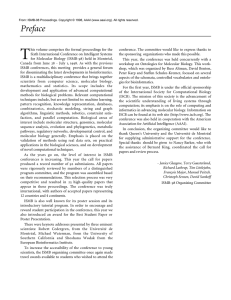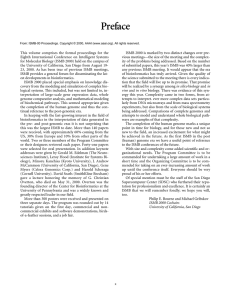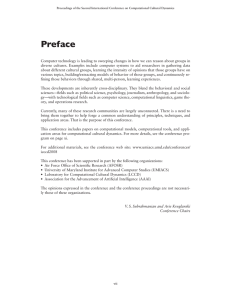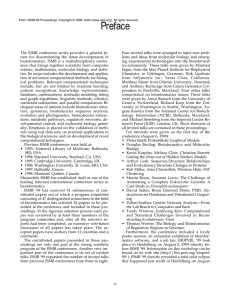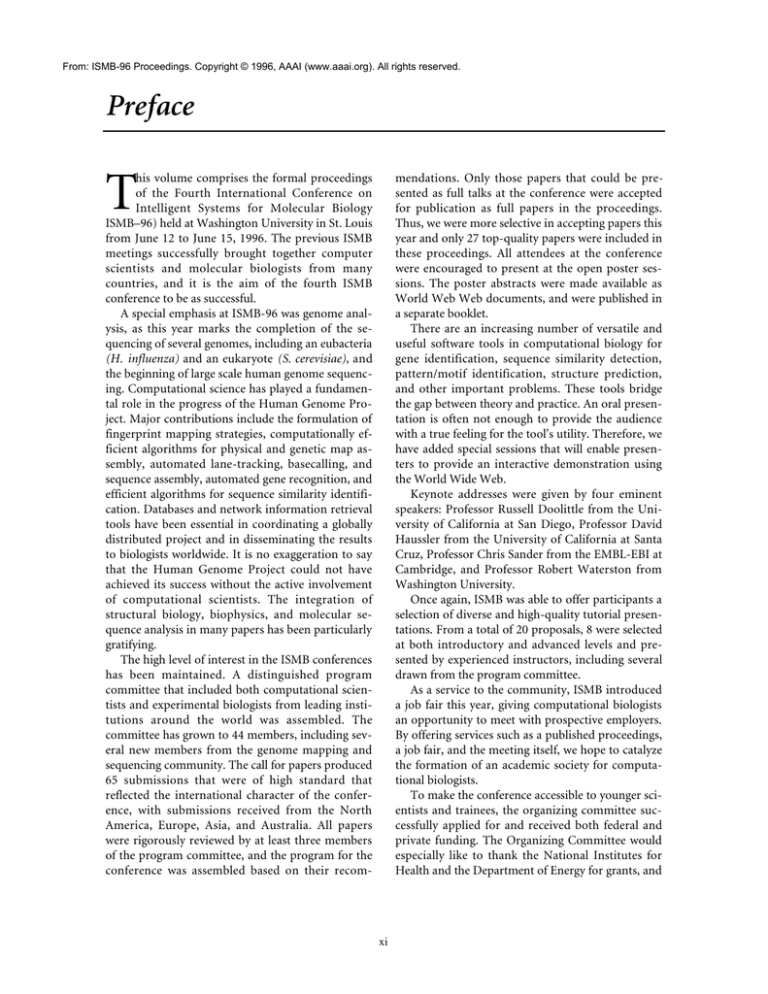
From: ISMB-96 Proceedings. Copyright © 1996, AAAI (www.aaai.org). All rights reserved.
Preface
T
his volume comprises the formal proceedings
of the Fourth International Conference on
Intelligent Systems for Molecular Biology
ISMB–96) held at Washington University in St. Louis
from June 12 to June 15, 1996. The previous ISMB
meetings successfully brought together computer
scientists and molecular biologists from many
countries, and it is the aim of the fourth ISMB
conference to be as successful.
A special emphasis at ISMB-96 was genome analysis, as this year marks the completion of the sequencing of several genomes, including an eubacteria
(H. influenza) and an eukaryote (S. cerevisiae), and
the beginning of large scale human genome sequencing. Computational science has played a fundamental role in the progress of the Human Genome Project. Major contributions include the formulation of
fingerprint mapping strategies, computationally efficient algorithms for physical and genetic map assembly, automated lane-tracking, basecalling, and
sequence assembly, automated gene recognition, and
efficient algorithms for sequence similarity identification. Databases and network information retrieval
tools have been essential in coordinating a globally
distributed project and in disseminating the results
to biologists worldwide. It is no exaggeration to say
that the Human Genome Project could not have
achieved its success without the active involvement
of computational scientists. The integration of
structural biology, biophysics, and molecular sequence analysis in many papers has been particularly
gratifying.
The high level of interest in the ISMB conferences
has been maintained. A distinguished program
committee that included both computational scientists and experimental biologists from leading institutions around the world was assembled. The
committee has grown to 44 members, including several new members from the genome mapping and
sequencing community. The call for papers produced
65 submissions that were of high standard that
reflected the international character of the conference, with submissions received from the North
America, Europe, Asia, and Australia. All papers
were rigorously reviewed by at least three members
of the program committee, and the program for the
conference was assembled based on their recom-
mendations. Only those papers that could be presented as full talks at the conference were accepted
for publication as full papers in the proceedings.
Thus, we were more selective in accepting papers this
year and only 27 top-quality papers were included in
these proceedings. All attendees at the conference
were encouraged to present at the open poster sessions. The poster abstracts were made available as
World Web Web documents, and were published in
a separate booklet.
There are an increasing number of versatile and
useful software tools in computational biology for
gene identification, sequence similarity detection,
pattern/motif identification, structure prediction,
and other important problems. These tools bridge
the gap between theory and practice. An oral presentation is often not enough to provide the audience
with a true feeling for the tool's utility. Therefore, we
have added special sessions that will enable presenters to provide an interactive demonstration using
the World Wide Web.
Keynote addresses were given by four eminent
speakers: Professor Russell Doolittle from the University of California at San Diego, Professor David
Haussler from the University of California at Santa
Cruz, Professor Chris Sander from the EMBL-EBI at
Cambridge, and Professor Robert Waterston from
Washington University.
Once again, ISMB was able to offer participants a
selection of diverse and high-quality tutorial presentations. From a total of 20 proposals, 8 were selected
at both introductory and advanced levels and presented by experienced instructors, including several
drawn from the program committee.
As a service to the community, ISMB introduced
a job fair this year, giving computational biologists
an opportunity to meet with prospective employers.
By offering services such as a published proceedings,
a job fair, and the meeting itself, we hope to catalyze
the formation of an academic society for computational biologists.
To make the conference accessible to younger scientists and trainees, the organizing committee successfully applied for and received both federal and
private funding. The Organizing Committee would
especially like to thank the National Institutes for
Health and the Department of Energy for grants, and
xi
Glaxo Wellcome PLC, Millennium Pharmaceutical,
and SmithKline Beecham Pharmaceuticals for generous donations. The American Association for Artificial Intelligence provided support for the publication of these proceedings. Thanks must also go to the
faculty and staff of the host organization, namely the
Institute for Biomedical Computing at Washington
University for providing invaluable administrative
and organizational support.
In conclusion, the organizing committee would
like to thank Debbie Peterson, Leslie Nelson, and
Ken Kaiser for business and administrative support,
Shirley Gonzalez-Rubio for coordinating the review
process, and Hugh Chou for maintaining our World
Wide Web services. We also wish to thank Evelyn
Boyle for her assistance in transferring databases and
information from ISMB-95, the ISMB steering group
for advice and assistance, and Mike Hamilton at
AAAI press for producing a quality proceedings.
– David J. States,
Pankaj Agarwal,
Terry Gaasterland,
Lawrence Hunter, &
Randall F. Smith.
ISMB-95 Organizing Committee
xii

